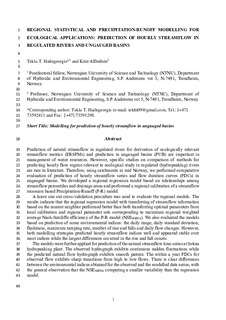| dc.contributor.author | Hailegeorgis, Teklu Tesfaye | |
| dc.contributor.author | Alfredsen, Knut | |
| dc.date.accessioned | 2018-01-26T14:59:20Z | |
| dc.date.available | 2018-01-26T14:59:20Z | |
| dc.date.created | 2016-02-22T18:06:39Z | |
| dc.date.issued | 2017 | |
| dc.identifier.citation | Rivers Research and Applications: an international journal devoted to river research and management. 2017, 33 (2), 233-248. | nb_NO |
| dc.identifier.issn | 1535-1459 | |
| dc.identifier.uri | http://hdl.handle.net/11250/2479994 | |
| dc.description.abstract | Prediction of natural streamflow in regulated rivers for derivation of ecologically relevant streamflow metrics (ERSFMs) and prediction in ungauged basins (PUB) are important in management of water resources. However, specific studies on comparison of methods for predicting hourly flow regime relevant to ecological study in regulated (hydropeaking) rivers are rare in literature. Therefore, using catchments in mid Norway, we performed comparative evaluation of prediction of hourly streamflow series and flow duration curves (FDCs) in ungauged basins. We developed a regional regression model based on relationships among streamflow percentiles and drainage areas and performed a regional calibration of a streamflow recession based precipitation–runoff (P–R) model.
A leave one out cross-validation procedure was used to evaluate the regional models. The results indicate that the regional regression model with transferring of streamflow information based on the nearest neighbour performed better than both transferring optimal parameters from local calibration and regional parameter sets corresponding to maximum regional weighted average Nash–Sutcliffe efficiency of the P–R model (NSEMRWA). We also evaluated the models based on prediction of some environmental indices: the daily range, daily standard deviation, flashiness, maximum ramping rate, number of rise and falls and daily flow changes. However, both modelling strategies predicted hourly streamflow indices well and appeared stable over most indices while the largest differences occurred in the rise and fall counts.
The models were further applied for prediction of the natural streamflow time series at Sokna hydropeaking plant. The observed hydrograph exhibits continuous sudden fluctuations while the predicted natural flow hydrograph exhibits smooth pattern. The within a year FDCs for observed flow exhibits sharp transitions from high to low flows. There is clear differences between the environmental indices obtained for the observed and the modelled data series, with the general observation that the NSEMRWA computing a smaller variability than the regression model. | nb_NO |
| dc.language.iso | eng | nb_NO |
| dc.publisher | Wiley | nb_NO |
| dc.title | Regional Statistical and Precipitation–Runoff Modelling for Ecological Applications: Prediction of Hourly Streamflow in Regulated Rivers and Ungauged Basins | nb_NO |
| dc.type | Journal article | nb_NO |
| dc.type | Peer reviewed | nb_NO |
| dc.description.version | acceptedVersion | nb_NO |
| dc.source.pagenumber | 233-248 | nb_NO |
| dc.source.volume | 33 | nb_NO |
| dc.source.journal | Rivers Research and Applications: an international journal devoted to river research and management | nb_NO |
| dc.source.issue | 2 | nb_NO |
| dc.identifier.doi | 10.1002/rra.3006 | |
| dc.identifier.cristin | 1338917 | |
| dc.relation.project | Norges forskningsråd: 193818 | nb_NO |
| dc.description.localcode | This is the peer reviewed version of the following article: [Regional Statistical and Precipitation–Runoff Modelling for Ecological Applications: Prediction of Hourly Streamflow in Regulated Rivers and Ungauged Basins], which has been published in final form at [http://onlinelibrary.wiley.com/doi/10.1002/rra.3006/abstract]. This article may be used for non-commercial purposes in accordance with Wiley Terms and Conditions for Self-Archiving. | nb_NO |
| cristin.unitcode | 194,64,91,0 | |
| cristin.unitname | Institutt for bygg- og miljøteknikk | |
| cristin.ispublished | true | |
| cristin.fulltext | postprint | |
| cristin.qualitycode | 1 | |
